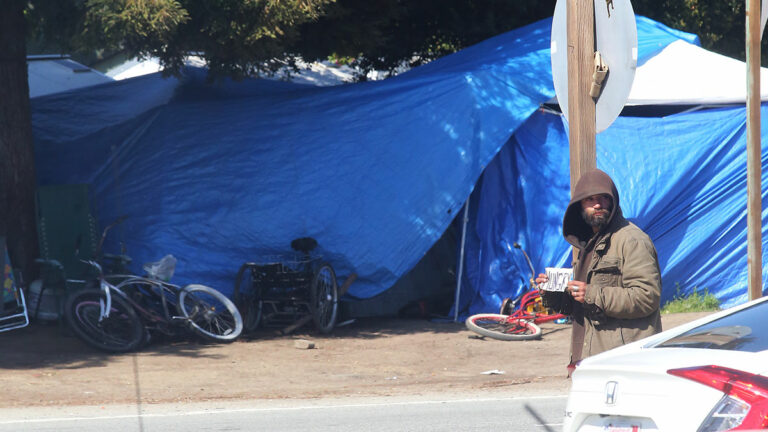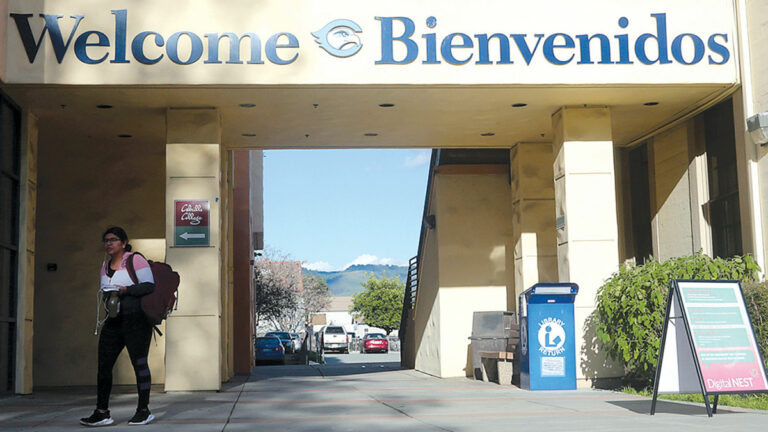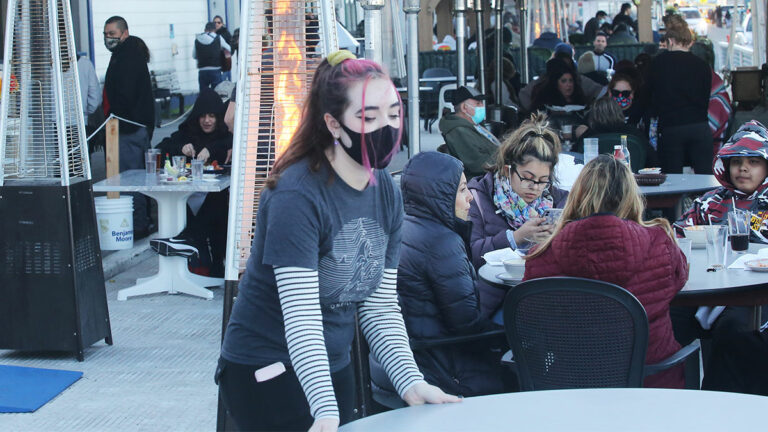[This is part one of a two-part series on homelessness. Part two runs next week. — Editor]
As he folds up blankets underneath the footbridge that spans the San Lorenzo River, Cyprus, a 39-year-old homeless resident of Santa Cruz, says the growing problems around homelessness locally have spiraled “out of control.”
San Lorenzo Park’s encampment, where he has been living, has its moments, though.
“As long as people here are peaceful, this is a nice place,” he says. “But sometimes people get into shouting and fights over petty stuff.”
As the Santa Cruz City Council prepares to finalize an ordinance that would bar camping in parks, Cyprus and those like him are wondering where they will go. “I just don’t see why this city can’t make a park where we can go and live,” Cyprus says.
Over the past three years, police officers, firefighters and city workers have repeatedly shut down one homeless encampment after another, but they have little to show for it other than a trail of former camps across the city.
About a mile upstream from the San Lorenzo Park footbridge, the Housing Matters campus is still offering free showers, mail pickup and other services. On the back wall behind the campus hangs a sign visible to drivers on Highway 1 that proudly boasts of the success of a campaign to house homeless residents. It reads, “950 people housed!”
Directly below is a long chain of tents, tarps, trash cans and beaten-up bicycles—one of Santa Cruz’s largest homeless encampments.
HOUSING STATUS
The multi-year campaign to get homeless residents a place to call their own—an effort now known as 180 Together—has housed more than 1,100 people, says Phil Kramer, executive director of the Housing Matters homeless shelter and services hub.
180 Together project first launched in 2012 under the name 180/180. The initiative’s staff worked to help clients secure Housing Choice Vouchers—sometimes known as Section 8—from the Housing Authority, find places to live and get the help they need to stay in their new home.
As part of the premise, the 180 program made a bold promise.
Kramer, the group’s original project manager, and other leaders announced that they would house 180 homeless people and help them find housing—thus turning around their lives (i.e., a 180-degree pivot)—within two years. But the initiative exceeded its original aim and rebranded to 180/2020 not long after. When it did, the group also upped the ante with a revised goal: to end chronic homelessness altogether by the year 2020. Chronic homelessness refers to someone who has been homeless for at least a year while suffering from a disabling condition, such as mental illness, a substance disorder or a physical disability.
It came as little surprise that the second goal proved to be a heavier lift than the first one—and went unmet. Although the 2019 homeless census showed a dip in the county’s homeless population, Santa Cruz’s encampments are as big as ever. And so after missing its target, the effort rebranded again—this time without a timeline—to 180 Together. The goal is still to end homelessness.
The process of housing 1,100 people over the course of eight-and-a-half years is a remarkable achievement. Even so, it’s been difficult to piece together a full progress report on the effectiveness of the campaign. What we know about the results has been mixed.
A 2020 Santa Cruz County Civil Grand Jury report that was mostly critical of a somewhat disorganized local response to homelessness did see a silver lining when it noted that at least 350 of those helped through the 180 program had been permanently housed.
Reading between the lines, however, the status of some 600 others was unclear. Do they still have a place to live? How many have moved? How many still live in the country?
No one can really say.
In addition to its bold promises, the 180 project’s vision in 2012 was grandiose. Proponents sold the housing-first strategy as an all-encompassing and evidence-based strategy to reduce suffering, ameliorate the quality-of-life impacts on the broader community and improve health outcomes for those on the streets—all while saving money on the crisis-mode revolving door of services.
No one is saying the “housing-first” approach—as it’s often known—has been a failure. But for all the talk of evidence-based best practices at the time, hard evidence of how exactly everything is working locally has been rather scarce ever since. Seven years ago, UCSC sociology professor Heather Bullock began work on a study of the 180 program’s effectiveness, as I reported for Santa Cruz Weekly at the time, but Bullock says she and her team never completed the survey.
Nonetheless, support for housing-first strategies has only grown since 2012. They are seen as best practices all over the nation, from Santa Cruz County to the federal government.
But measuring some aspects of the 180 project’s effectiveness is easier said than done, Kramer says. Case managers from the 180 Together program offer support to newly housed clients for up to a year. After that, maintaining contact can be difficult, he says.
“That’s not for a lack of desire,” he says. “It’s just the practical realities of someone’s circumstance and situation—staying in touch with them after a year. And we don’t have funding, honestly, to provide that kind of ongoing year-two, year-three or four or five followup. But it’s something that’s needed.”
Staying in touch isn’t easy. Clients may move; their phone numbers may change. And because the need for services is so high, 180’s staffers are constantly moving on to help the next client, Kramer says. “It really is a difficult situation,” he says.
Kramer knows that a life-changing crisis could destabilize anyone. Part of the hope, he explains, is that each client will know to call a social worker and ask for help if they need it—and before they end up back on the street.
“We know that there aren’t enough supportive services—case management, housing navigation, care management—to go around,” he says.
ROUSING FIRST
In recent years, some homeless advocates have begun to question the effectiveness of the housing-first paradigm.
Brent Adams, who leads the Warming Center Program and other services, wonders if it would ever be possible to end chronic homelessness locally in the first place. He also says he can help far more people and reduce suffering in the homeless community for a fraction of the cost—offering free storage, free laundry services and often a place to spend the night, all on a meager budget.
Some of these are programs that the city approved in concept four years ago, via the Homelessness Coordinating Committee, but never actually created. Although Adams has secured some local government funding and recently began hiring staff, his programs have mostly gotten by on fundraising and long hours from volunteers.
“We’re kind of like pirates on the seas doing this work, which means we get by with the help from our friends,” he says.
Clean laundry and a place to put things are the aspects of everyday life that housed people take for granted. Losing them can mean everything, Adams says. “If you remove laundry and storage, all of a sudden, we’re dirty, disheveled and carrying our things around,” he says.
In conversation, Adams—a longtime activist who seeks to build bridges, not burn them—is constantly evaluating how much he really wants to say in his critique of the status quo on local homeless response.
But once he gets on a roll, he does not mince words. Adams says that, since changing its name from the Homeless Services Center to Housing Matters, Santa Cruz’s local shelter campus has made other changes as well. He contends that the campus “turned their name and their back away from services toward that national paradigm, the housing-first model, and that’s what really they’re about.”
Kramer says it isn’t true that Housing Matters turned its back on anyone. The shift toward housing has augmented the Coral Street center’s homeless services, he says—not replaced them.
“We haven’t changed. We continue to operate hot showers and bathrooms. We’re open to the public. You don’t have to be in our program. We have bathrooms open 24/7. We have access to U.S. Postal Office mail here to anyone in the county. You don’t have to be in our program or service. If you don’t have an address, you can use Coral Street,” says Kramer, who also says he has a deep appreciation for the mix of services that Adams provides, all of which Kramer says are absolutely vital.
BARRIERS TO SUCCESS
But when it comes to securing homes for vulnerable populations and turning local housing-first plans into a success, there are four major barriers that staff run into. Each one is a bottleneck all its own: there’s the county’s limited housing supply, the limited supply of federally allocated housing vouchers, the limited number of social workers to shepherd applicants through the application process and the struggle to find enough landlords willing to say yes to someone on Section 8.
“Those are bottlenecks at any given time,” Kramer says. “Sometimes we have enough vouchers. ‘Great—we have enough vouchers!’ But I don’t have enough case managers to go along with the voucher and the program participant.”
The ramifications from many of these limitations extend well beyond the homeless population.
A housing-choice voucher is not a homeless-oriented benefit, per se. Such vouchers, which are in limited supply, are available to many low-income residents who apply and stay on the waiting list long enough—a time spanning many years—to secure one. That is when the waiting list is open. That list has been closed for two years because the wait was getting so long.
Jenny Panetta, executive director of the local Housing Authority, says that as of last count, (which was before the economic disruptions wrought by the Covid-19 pandemic), the number of renters who qualified for a Housing Choice Vouchers was six times greater than the number of local vouchers available.
Nonetheless, the Housing Authority of Santa Cruz County has scored some big wins. Those include a successful campaign to increase federally established rental rates by 24%. (Previously, the region’s fair-market rent was low, compared to the actual rental rate in Santa Cruz, meaning that a landlord would settle for less money when renting to a Section 8 tenant.) Then there was the launch of a Landlord Incentive Program, a financial guarantee to landlords in response to storylines about Section 8 tenants posing financial risks to property owners. All of it appears to be working, according to both the numbers and the stories Panetta hears from tenants and landlords alike.
But many Section 8 tenants still see their vouchers expire before they find a landlord willing to give them a home.
“The need is staggering,” Panetta says.
WALL-TO-WALL TENSION
It would be a worn-out cliché to suggest that Santa Cruz’s homeless response resembles a game of whack-a-mole—with the city constantly shutting down encampments and shuffling everyone along, only to see a similar camp pop up one block over.
In actuality, the core challenge isn’t that the problem keeps on popping up, like a grinning gopher at Chuck E. Cheese.
The situation is that Santa Cruz keeps shifting the impacts of homelessness around and hoping everyone will pretend that they’ve gone away. That’s why Santa Cruz’s homeless strategy is more akin to a janitor without a dustpan, hopelessly sweeping in circles and wondering why everyone is stepping in his dust piles.
And when tensions understandably run high, it’s sometimes easy to forget that homelessness—not an isolated encampment—is the central crisis.
Presently, much of the focus is on the Highway 1 shoulder, near River Street, where an encampment has sat backed up to the rear wall of Housing Matters since summer. It’s also where work is slated to begin next month on a plan to widen the highway and build a new seven-lane bridge. Santa Cruz Mayor Donna Meyers has asked Gov. Gavin Newsom for his help clearing the camp and providing emergency shelter. Meyers says that since then, Santa Cruz employees have been in almost daily contact with CalTrans to resolve the issue.
Meanwhile, the city is embroiled in a debate over its recently approved Temporary Outdoor Living Ordinance. Santa Cruz’s staff and City Council crafted this new law to comply with existing case law. Unlike the old camping ban, the law doesn’t outright prohibit sleeping citywide. Instead, it prohibits all camping during the day and puts large swaths of the city, including parks and residential neighborhoods, off limits for sleeping at all hours. Under the law, anyone sleeping outside will have to break down camp each morning. The city will create its own storage program and safe sleeping areas with room for 150 tents.
“We aren’t saying, ‘You can’t camp or can’t sleep at night,’ but we are saying, ‘You cannot set up permanent encampments during the day in the parks.’ And the way we are managing that is saying, ‘You can’t set up a tent during the day anywhere in the city of Santa Cruz,” Meyers explains.
After two readings, the City Council approved the ordinance at a tense meeting earlier this month, but the city will vote on amendments to it in April, and the new law won’t take effect until mid-May at the earliest. Meyers feels the plan has garnered a lot of negative attention from homeless advocates and some activists, but she also says that people, often parents, have been coming up to her and calling her to tell her how much they appreciate the change.
Meyers says it isn’t the goal to push unsheltered people out of the city of Santa Cruz, but she believes some of them may, in fact, move along.
“It’s not the intent to get rid of the homeless people in Santa Cruz, but it’s certainly to acknowledge that we don’t have enough shelter beds here,” she says. “So if you’re trying to be here in a shelter situation, it’s going to be very difficult, because we just don’t have a lot of resources. It’s not the intent to move people along, but we will provide more resources and hopefully more capabilities for people to get in touch and part of the system of care.”
For longer-range goals, Meyers says she wants Santa Cruz to build more shelters and get more homeless people housed.
When it comes to the new camping ordinance, the city will smooth out some wrinkles in the amendment process, even drawing up a map of where homeless people will be allowed to sleep outside. The city will also allow churches and nonprofits to step up and manage their own encampments.
But the city could have worked through many of those issues before creating such a big public struggle over the matter, says Councilmember Justin Cummings, one of two dissenting votes on both rounds of the ordinance. Cummings feels the whole process has been rushed from the start, and he doesn’t understand the hurry—especially considering the law won’t take effect for another couple months, anyway, maybe longer.
The city, he notes, never reached out to churches or other possible camp managers, like Adams of the Warming Center. Cummings adds that some other aspects of the ordinance—ones that he says the city didn’t fully think through beforehand—blindsided the neighbors of some communities, creating an unnecessary public relations snafu.
But the most frustrating part to Cummings is that he remembers when former Councilmember Drew Glover, an ally of Cummings, tried to rush through his own homeless ordinance in 2019. Councilmembers like Meyers harshly criticized Glover—since recalled from office—for not reaching out to stakeholders beforehand.
Cummings has a tough time seeing how the public process around the new ordinance is any better than what Glover tried to do two years ago. It’s a double standard, he says.
“Some of what’s being proposed here is the same stuff [Glover] brought up,” Cummings says. “And looking at both approaches, he got criticized for not going to the community, and rightfully so. And the councilmembers who’re bringing this forward haven’t done the outreach, either.”
HOUSE EVERYBODY?
There are many unknowns around how the Temporary Outdoor Living Ordinance will play out.
No one outside of Santa Cruz city government has seen the updated map of where people will be allowed to camp. Also, everyone will have to wait and see how many groups actually step forward and offer to run their own encampments. But perhaps most importantly, it’s an open question right now how exactly Santa Cruz police officers will even enforce the law once it takes effect.
Five years from now, such details may all seem like a blip compared to the broader goals involved in reducing the suffering of people on the street, as well as the impact that they have on everyone else.
There’s an irony to the rift over the feasibility of the housing-first approach. One might assume that Santa Cruz’s most liberal activists—Adams of the Warming Center included—would be pushing for the most radical solutions. When it comes to homelessness, however, those ideas have gone mainstream; we hear them from nonprofit executives, politicians and government bureaucrats. By contrast, Adams’ pitch of managing people’s basic needs is more practical—and perhaps more realistic, depending on your view.
In any case, 180 Together is hardly the only group doubling down on housing-first strategies. Other nonprofits, like Encompass, have their own housing navigators, as does Santa Cruz County.
Right now, Santa Cruz County is working with Housing Matters to find permanent homes for the 200 elderly and medically vulnerable homeless residents who’ve spent the past year staying in motels on temporary vouchers due to disease risk posed by the Covid-19 pandemic. The program is called Housing Now.
Housing is hardly a new focus for the county. The county launched a pilot project called Whole Person Care—Cruz to Health, aimed at improving health outcomes for the county’s most vulnerable residents, particularly homeless people, in 2015. County health workers quickly realized that housing was the most important key for getting homeless people healthy, Public Health Manager Emily Chung told me last year. More recently, the county Board of Supervisors approved its Housing for a Healthy Santa Cruz plan just last week, with the goal of cutting homelessness 25% by the start of 2024. The target is less ambitious than previous goals, like an ill-fated 2015 promise that the county signed onto to end veteran homelessness by the end of 2016.
Kramer, the Housing Matters executive director, wouldn’t chide anyone for making big, bold goals—even when they prove challenging. For one thing, it’s a reminder that there’s more work to do. Plus, he remembers skeptics questioning if it was possible to meet its goal of housing 180 people all those years ago.
Housing Matters is currently remodeling a Victorian across the street from its campus into a seven-unit home for homeless people who will have easy access support and services.
Meanwhile, Housing Matters and New Way Homes are getting ready to build a 121-unit permanent supportive housing complex, the first of its kind locally. It will be on the Housing Matters campus—with case management and medical facilities on site.
“We need more. I’m not thinking big enough, right?” Kramer says. “We need four or five of these throughout the county and more services. As much as this feels like a big move for us to make—and it is—we need to think even bigger.”
Tarmo Hannula contributed to this story.
Update March 24, 7pm: A previous version of this story did not fully capture Housing Matters’ role in building the new permanent supportive housing complex on its campus.
























